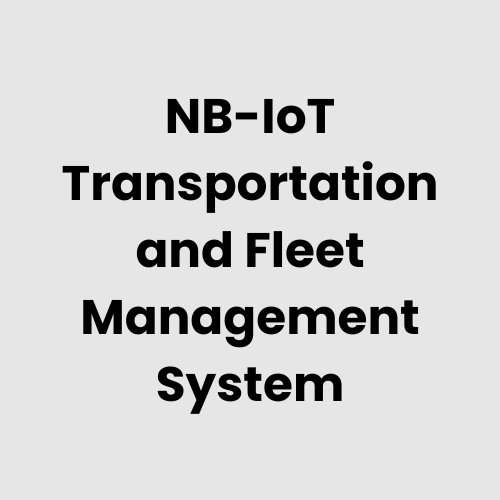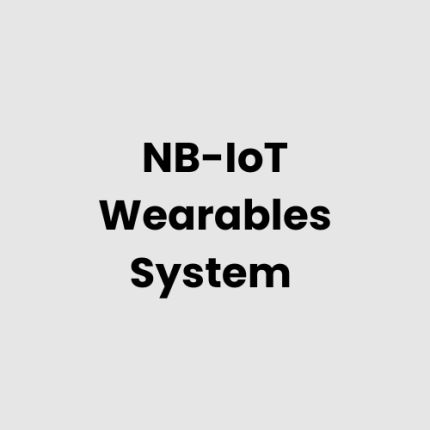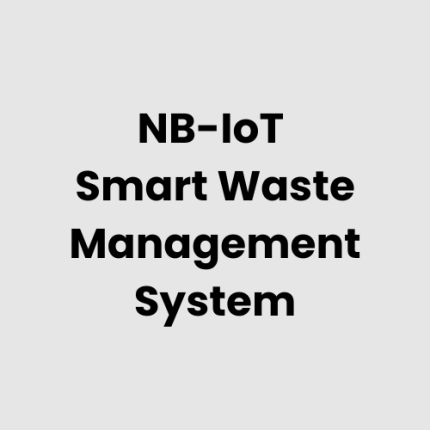Description
Technical Architecture of the NB-IoT Enabled Transportation and Fleet Management System
The NB-IoT Enabled Transportation and Fleet Management System consists of interconnected layers:
- Device Layer: Includes NB-IoT-enabled sensors and tracking devices for real-time data collection.
- Network Layer: Utilizes low-power NB-IoT networks for secure, long-range communication.
- Processing Layer: Local or cloud-based servers process data for analytics and decision-making.
- Application Layer: User-friendly interfaces for fleet managers to access dashboards, reports, and alerts.
- Integration Layer: Ensures compatibility with third-party enterprise resource planning (ERP) and logistics management systems.
GAO Tek’s robust architecture supports scalability and secure data exchange, catering to dynamic transportation needs.
List of Hardware for the NB-IoT Enabled Transportation and Fleet Management System
- Vehicle-Mounted NB-IoT GPS Trackers
- Telematics Control Units (TCUs)
- Environmental Sensors: For temperature, humidity, and air quality monitoring.
- Tire Pressure Monitoring Sensors
- Onboard Diagnostics (OBD-II) Modules
- Gateway Devices: Connect sensors to the NB-IoT network.
- Driver Behavior Monitors: Assess speed, acceleration, and braking patterns.
- Asset Tags: For tracking cargo and equipment.
- Base Stations: To support wide-area network connectivity.
- Edge Computing Devices: For preprocessing data near the source.
Physical Placement Considerations of Hardware
- Vehicle-Mounted Sensors: Installed in discreet and weatherproof locations to ensure durability.
- Gateways: Positioned in fleet depots to maximize connectivity.
- OBD-II Modules: Connected to the vehicle’s diagnostic port for real-time engine data.
- Environmental Sensors: Placed in cargo areas to monitor conditions during transit.
- Base Stations: Deployed at strategic intervals to ensure seamless network coverage.
GAO Tek’s installation services ensure optimal placement for maximum operational efficiency and longevity.
Hardware Architecture of the NB-IoT Enabled Transportation and Fleet Management System
The hardware architecture is built around modular components to enable flexibility:
- Core Devices: Sensors and trackers with low-power consumption and extended battery life.
- Data Collection Gateways: Support multi-channel data aggregation.
- Power Systems: Solar panels, battery packs, and vehicle-based power supplies.
- Connectivity Backbone: NB-IoT modules embedded in devices for real-time data transmission.
GAO Tek’s designs adhere to stringent quality standards, ensuring system reliability in demanding environments.
Deployment Considerations
- Scalability: Configurable solutions to accommodate growing fleets.
- Data Security: End-to-end encryption and secure NB-IoT protocols.
- Integration: Compatibility with existing fleet management software and ERP systems.
- Network Coverage: Deployment of NB-IoT base stations for comprehensive coverage.
- Regulatory Compliance: Adherence to transportation, environmental, and IoT-specific standards.
List of Relevant Industry Standards and Regulations
- ISO 26262 (Automotive Safety)
- ETSI TS 103 645 (IoT Cybersecurity)
- SAE J1939 (Vehicle Networking)
- FCC Regulations (Radiofrequency)
- GDPR (Data Protection)
- NHTSA Guidelines (Fleet Safety)
- ISO 15118 (Vehicle-to-Grid Communication)
- IETF IoT Standards
- UNECE R10 (Electronic Equipment Approval)
Local Server Version
The local server version of the NB-IoT Enabled Transportation and Fleet Management System supports on-premises data processing and storage for enhanced control. It features:
- Dedicated Servers: Installed at fleet depots or corporate locations.
- Data Access: Offline data analysis capabilities.
- Security: Enhanced physical and digital security measures.
GAO Tek provides expert support for setting up and maintaining local servers, ensuring minimal downtime and maximum reliability.
Cloud Integration and Data Management
The cloud-integrated version enables real-time global access to data through secure, scalable infrastructure. Key features include:
- Data Analytics: AI-driven insights for route optimization and predictive maintenance.
- Remote Monitoring: Access to dashboards from any location.
- Scalability: Pay-as-you-go model for growing fleets.
- API Integration: Seamless connectivity with third-party platforms.
GAO Case Studies of NB-IoT Enabled Transportation and Fleet Management System
USA Case Studies
- New York City, New York
An NB-IoT-enabled transportation system optimized the city’s public bus fleets, using real-time tracking and predictive maintenance to reduce operational downtime and improve rider experience. For more on IoT-enabled smart cities, see NIST’s Internet of Things Standards. - San Francisco, California
This city used NB-IoT to optimize electric vehicle fleets, focusing on sustainability and energy efficiency. The solution improved routing and scheduling for eco-friendly transit. Learn more about energy-efficient IoT from DOE’s Office of Energy Efficiency and Renewable Energy. - Houston, Texas
NB-IoT technology facilitated advanced cargo monitoring across freight fleets, enhancing compliance with the Federal Motor Carrier Safety Administration (FMCSA). Read FMCSA’s compliance guidelines here. - Chicago, Illinois
With GAO Tek’s guidance, Chicago adopted NB-IoT systems to streamline public transit operations and reduce delays. Learn about IoT integration in urban infrastructure from the Smart Cities Council. - Phoenix, Arizona
A logistics company deployed NB-IoT to monitor fleet health and cargo status in high-temperature conditions, showcasing the reliability of IoT in harsh climates. Explore IoT in logistics via IEEE Xplore. - Boston, Massachusetts
School buses in Boston integrated NB-IoT for tracking student safety and operational efficiency. Parents gained real-time location updates for enhanced peace of mind. Learn about IoT in school systems from Education Week. - Miami, Florida
NB-IoT systems were implemented in tourism shuttles for live tracking and vehicle monitoring, boosting satisfaction in Miami’s competitive tourism market. Explore smart tourism solutions at UNWTO. - Dallas, Texas
Waste management fleets in Dallas optimized routes using IoT-enabled load sensors, reducing emissions and improving collection efficiency. For sustainability applications, visit EPA’s IoT for Environmental Management. - Denver, Colorado
NB-IoT sensors in snowplow fleets ensured timely response during snowstorms, safeguarding public safety. Find more on IoT in public safety from DHS’s Science and Technology Directorate. - Seattle, Washington
A delivery company adopted NB-IoT systems for improved routing and tracking, enhancing last-mile logistics. Learn more about IoT logistics from DHL’s IoT Logistics Insights. - Atlanta, Georgia
Atlanta deployed NB-IoT systems to alleviate traffic congestion and coordinate public transit schedules. Learn about IoT in urban mobility from ITS America. - Las Vegas, Nevada
NB-IoT-enhanced ride-hailing services optimized vehicle allocation for major events, improving wait times and traffic flow. Explore IoT for mobility services at ITS International. - Los Angeles, California
Delivery fleets in Los Angeles used NB-IoT to combat urban traffic delays, ensuring efficient package delivery. Learn about IoT in urban delivery from World Economic Forum. - Detroit, Michigan
NB-IoT systems supported just-in-time delivery by monitoring parts inventory across automotive fleets. Learn more about automotive IoT innovations at SAE International. - Orlando, Florida
Shuttle buses in Orlando’s theme parks adopted NB-IoT for seamless transit coordination, reducing waiting times and improving visitor satisfaction. Explore IoT in leisure management from World Tourism Organization.
Case Studies in Canada
- Toronto, Ontario
Toronto integrated NB-IoT into its municipal transit systems, enhancing fleet efficiency and passenger satisfaction. Explore urban IoT deployments at Canada Smart Cities Challenge. - Montreal, Quebec
Montreal logistics firms utilized NB-IoT systems to monitor sensitive cargo during transit, ensuring compliance with international shipping regulations. Learn more about IoT for supply chain monitoring at Transport Canada.
Navigation Menu for NB-IoT
Navigation Menu for IoT
- LORAWAN
- Wi-Fi HaLow
- Z-WAVE
- BLE & RFID
- NB-IOT
- CELLULAR IOT
- GPS IOT
- IOT SENSORS
- EDGE COMPUTING
- IOT SYSTEMS
Our products are in stock and can be shipped anywhere in the continental U.S. or Canada from our local warehouse. For any further information, please fill out this form or email us.
We are actively looking for partners who are like us located in the U.S. and Canada. For more information on partnering with GAO, please visit Partner with GAO Tek Inc. It lists various ways to partner with GAO, such as OEM Partnerships, Technology Integration, Distribution and Reselling Opportunities, Presenting at the Leading Event Tek Summit, Joint R&D Projects, Training and Consulting Services, Industry-Specific Collaborations, Research and Academic Partnerships.



